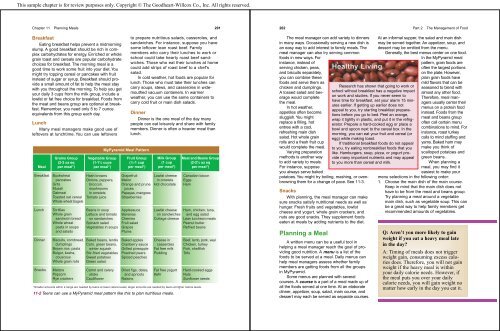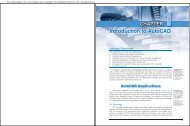Planning Meals - Goodheart-Willcox
Planning Meals - Goodheart-Willcox
Planning Meals - Goodheart-Willcox
Create successful ePaper yourself
Turn your PDF publications into a flip-book with our unique Google optimized e-Paper software.
This sample chapter is for review purposes only. Copyright © The <strong>Goodheart</strong>-<strong>Willcox</strong> Co., Inc. All rights reserved.<br />
Chapter 11 <strong>Planning</strong> <strong>Meals</strong> 201<br />
Breakfast<br />
Eating breakfast helps prevent a midmorning<br />
slump. A good breakfast should be rich in complex<br />
carbohydrates for energy. Enriched or whole<br />
grain toast and cereals are popular carbohydrate<br />
choices for breakfast. The morning meal is a<br />
good time to work some fruit into your diet. You<br />
might try topping cereal or pancakes with fruit<br />
instead of sugar or syrup. Breakfast should provide<br />
a small amount of fat to help the meal stay<br />
with you throughout the morning. To help you get<br />
your daily 3 cups from the milk group, include a<br />
lowfat or fat free choice for breakfast. Foods from<br />
the meat and beans group are optional at breakfast.<br />
Remember, you need only 5 to 7 ounce<br />
equivalents from this group each day.<br />
Lunch<br />
Many meal managers make good use of<br />
leftovers at lunchtime. You can use leftovers<br />
Meal<br />
Breakfast<br />
Lunch<br />
Dinner<br />
Snacks<br />
Grains Group<br />
(2-3 oz eq<br />
per meal*)<br />
Buckwheat<br />
pancakes<br />
Grits<br />
Muesli<br />
Oatmeal<br />
Toasted oat cereal<br />
Whole wheat bagels<br />
Tortillas<br />
Whole grain<br />
sandwich bread<br />
Whole wheat<br />
pasta in soups<br />
and salads<br />
Biscuits, cornbread,<br />
dumplings<br />
Brown rice, pasta<br />
Bulgur, kasha,<br />
couscous<br />
Whole grain rolls<br />
Matzos<br />
Popcorn<br />
Rye crackers<br />
Vegetable Group<br />
(1-1½ cups<br />
per meal*)<br />
Hash browns<br />
Onions, peppers,<br />
broccoli,<br />
mushrooms<br />
in omelets<br />
Tomato juice<br />
Beans in soup<br />
Lettuce and tomato<br />
on sandwiches<br />
Spinach salad<br />
Vegetables in soups<br />
Baked beans, lentils<br />
Corn, green beans,<br />
winter squash<br />
Stir-fried vegetables<br />
Sweet potatoes<br />
Green salad<br />
Carrot and celery<br />
sticks<br />
Cauliflower<br />
MyPyramid Meal Pattern<br />
to prepare nutritious salads, casseroles, and<br />
sandwiches. For instance, suppose you have<br />
some leftover lean roast beef. Family<br />
members who carry their lunches to work or<br />
school could take hearty roast beef sandwiches.<br />
Those who eat their lunches at home<br />
could add strips of roast beef to a chef's<br />
salad.<br />
In cold weather, hot foods are popular for<br />
lunch. Those who must take their lunches can<br />
carry soups, stews, and casseroles in widemouthed<br />
vacuum containers. In warmer<br />
weather, you can use the same containers to<br />
carry cold fruit or main dish salads.<br />
Dinner<br />
Dinner is the one meal of the day many<br />
people can eat leisurely and share with family<br />
members. Dinner is often a heavier meal than<br />
lunch.<br />
Fruit Group<br />
(½-1 cup<br />
per meal*)<br />
Grapefruit<br />
Melon<br />
Orange and prune<br />
juices<br />
Papayas, mangoes<br />
Strawberries<br />
Applesauce<br />
Bananas<br />
Cherries<br />
Fruit salad<br />
Grapes<br />
Plums<br />
Baked apples<br />
Cranberry sauce<br />
Grilled pineapple<br />
Poached pears<br />
Spiced peaches<br />
Dried figs, dates,<br />
and apricots<br />
Raisins<br />
Milk Group<br />
(1 cup<br />
per meal*)<br />
Lowfat cheese<br />
in omelets<br />
Hot chocolate<br />
Lowfat cheese<br />
on sandwiches<br />
Cottage cheese<br />
Cheese in<br />
casseroles<br />
Fat free milk<br />
Pudding<br />
Fat free yogurt<br />
Kefir<br />
Meat and Beans Group<br />
(2-2½ oz eq<br />
per meal*)<br />
Canadian bacon<br />
Eggs<br />
Ham<br />
Ham, chicken, tuna,<br />
and egg salad<br />
Lean luncheon meats<br />
Peanut butter<br />
Refried beans<br />
Beef, lamb, pork, veal<br />
Chicken, turkey<br />
Fish, shellfish<br />
Tofu<br />
Hard-cooked eggs<br />
Nuts<br />
Sunflower seeds<br />
*Smaller amounts within a range are needed by teens at lower calorie levels; larger amounts are needed by teens at higher calorie levels.<br />
11-2 Teens can use a MyPyramid meal pattern like this to plan nutritious meals.<br />
202 Part 2 The Management of Food<br />
The meal manager can add variety to dinners<br />
in many ways. Occasionally serving a new dish is<br />
an easy way to add interest to family meals. The<br />
meal manager can also try serving common<br />
foods in new ways. For<br />
instance, instead of<br />
serving chicken, peas,<br />
and biscuits separately,<br />
you can combine these<br />
foods and serve them as<br />
chicken and dumplings.<br />
A tossed salad and beverage<br />
would complete<br />
the meal.<br />
In hot weather,<br />
appetites often become<br />
sluggish. You might<br />
replace a filling, hot<br />
entree with a cool,<br />
refreshing main dish<br />
salad. Hot whole grain<br />
rolls and a fresh fruit cup<br />
would complete the meal.<br />
Varying preparation<br />
methods is another way<br />
to add variety to meals.<br />
For instance, suppose<br />
you always serve baked<br />
potatoes. You might try boiling, mashing, or ovenbrowning<br />
them for a change of pace. See 11-3.<br />
Snacks<br />
With planning, the meal manager can make<br />
sure snacks satisfy nutritional needs as well as<br />
hunger. Fresh fruits and vegetables, lowfat<br />
cheese and yogurt, whole grain crackers, and<br />
nuts are good snacks. They supplement foods<br />
eaten at meals by adding nutrients to the diet.<br />
<strong>Planning</strong> a Meal<br />
Healthy Living<br />
A written menu can be a useful tool in<br />
helping a meal manager reach the goal of providing<br />
good nutrition. A menu is a list of the<br />
foods to be served at a meal. Daily menus can<br />
help meal managers assess whether family<br />
members are getting foods from all the groups<br />
in MyPyramid.<br />
Some menus are planned with several<br />
courses. A course is a part of a meal made up of<br />
all the foods served at one time. At an elaborate<br />
dinner, appetizer, soup, salad, main course, and<br />
dessert may each be served as separate courses.<br />
Research has shown that going to work or<br />
school without breakfast has a negative impact<br />
on work and studies. If you never seem to<br />
have time for breakfast, set your alarm 15 minutes<br />
earlier. If getting up earlier does not<br />
appeal to you, try starting breakfast preparations<br />
before you go to bed. Peel an orange,<br />
wrap it tightly in plastic, and put it in the refrigerator.<br />
Prepare a hard-cooked egg or place a<br />
bowl and spoon next to the cereal box. In the<br />
morning, you can eat your fruit and cereal (or<br />
egg) while making toast.<br />
If traditional breakfast foods do not appeal<br />
to you, try eating nonbreakfast foods that you<br />
like. Hamburgers, soup, pizza, or yogurt provide<br />
many important nutrients and may appeal<br />
to you more than cereal and milk.<br />
At an informal supper, the salad and main dish<br />
may be served together. An appetizer, soup, and<br />
dessert may be omitted from the menu.<br />
Generally, the best menus center on one food.<br />
In the MyPyramid meal<br />
pattern, grain foods are<br />
often the largest portions<br />
on the plate. However,<br />
plain grain foods have<br />
mild flavors that can be<br />
seasoned to blend with<br />
almost any other food.<br />
Therefore, meal managers<br />
usually center their<br />
menus on a protein food<br />
instead. Foods from the<br />
meat and beans group<br />
often call certain menu<br />
combinations to mind. For<br />
instance, roast turkey<br />
calls to mind stuffing and<br />
yams. Baked ham may<br />
make you think of<br />
scalloped potatoes and<br />
green beans.<br />
When planning a<br />
meal, you may find it<br />
easiest to make your<br />
menu selections in the following order:<br />
1. Choose the main dish of the main course.<br />
Keep in mind that the main dish does not<br />
have to be from the meat and beans group.<br />
Try planning a meal around a vegetable<br />
main dish, such as vegetable soup. This can<br />
be a great way to help family members get<br />
recommended amounts of vegetables.<br />
Q: Aren’t you more likely to gain<br />
weight if you eat a heavy meal late<br />
in the day?<br />
A: Timing of meals does not trigger<br />
weight gain, consuming excess calories<br />
does. Therefore, you will not gain<br />
weight if the heavy meal is within<br />
your daily calorie needs. However, if<br />
the meal puts you over your daily<br />
calorie needs, you will gain weight no<br />
matter how early in the day you eat it.

















